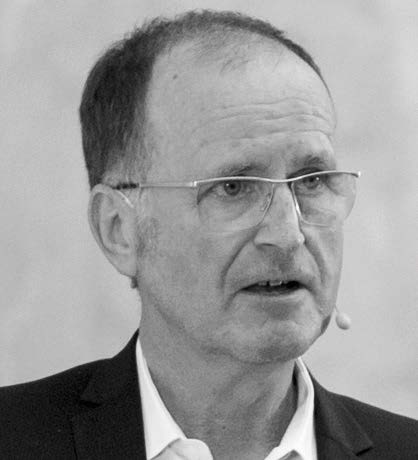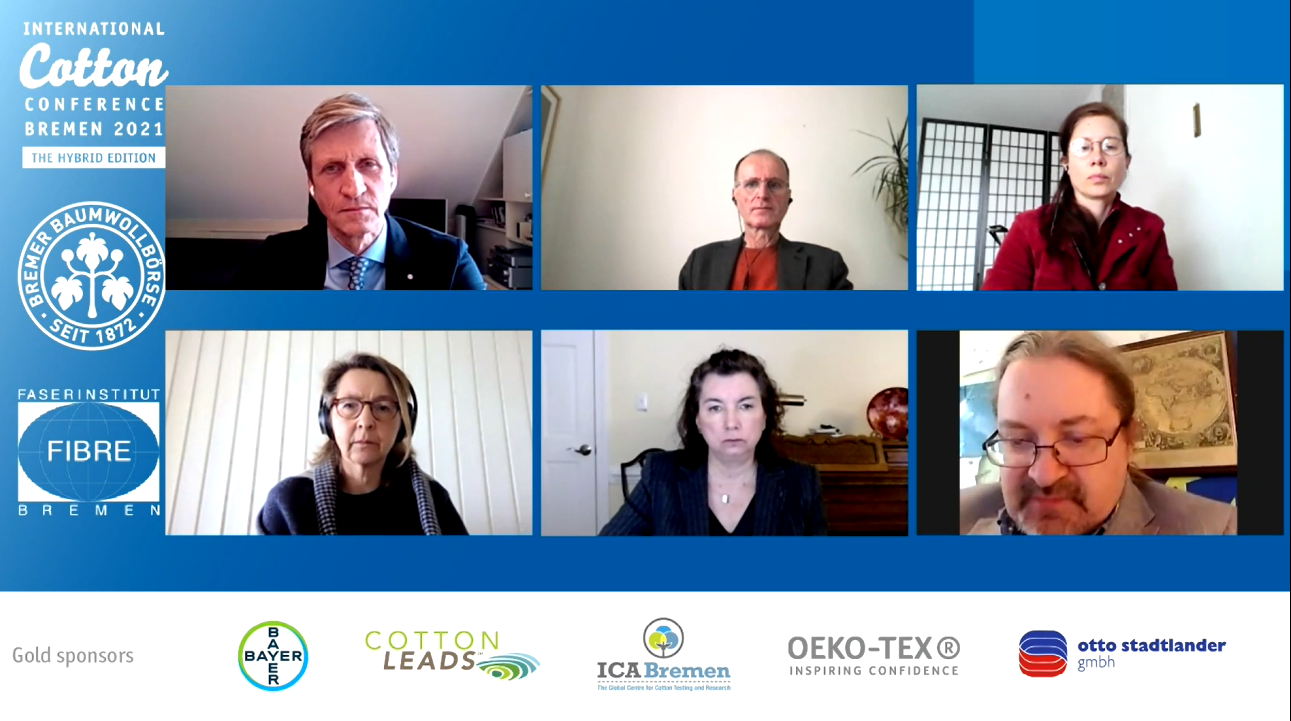Key topics of the 35th International Cotton Conference Bremen 2021
Circular economy was the topic of a central panel discussion at the International Cotton Conference Bremen. The panel was chaired by Simon Ferrigno, Writer and Researcher, Sustainable & Organic Farm Systems, UK. In his introduction, he observed that talking about a circular economy in the context of an annual crop might seem strange, but the cotton industry is taking an interesting approach considering resource scarcity and growing consumer demand for fibre products.
The panel discussion on circular economy for cotton and other natural fibres focussed on aspects of biodegradability and fibre blends as well as quality and longevity. In the context of the sustainability discussion, this was mainly about different concepts to conserve resources, to recycle and to avoid waste. Social and economic framework conditions were also part of the discussion.
 Dr Pamela Ravasio, Founder and Managing Director, Shirahime, Switzerland, presented a definition for the concept of a circular economy: The Ellen MacArthur Foundation describes a circular economic model as one that designs out waste and pollution, keeps materials and products in use, and regenerates natural systems and the biosphere. A fourth point is that circularity reframes our economy to be socially inclusive. A specific challenge for cotton in the circular economy is to reuse fibres, and she asked how can consumers be encouraged to return clothing for reuse. The production of clothing of mono-materials, rather than blends, would enable more recycling.
Dr Pamela Ravasio, Founder and Managing Director, Shirahime, Switzerland, presented a definition for the concept of a circular economy: The Ellen MacArthur Foundation describes a circular economic model as one that designs out waste and pollution, keeps materials and products in use, and regenerates natural systems and the biosphere. A fourth point is that circularity reframes our economy to be socially inclusive. A specific challenge for cotton in the circular economy is to reuse fibres, and she asked how can consumers be encouraged to return clothing for reuse. The production of clothing of mono-materials, rather than blends, would enable more recycling.
 Kjersti Kviseth, Lifecycler, 2025 Design, Norway worked in the fashion industry pioneering circular design systems for 25 years. She believes that a circular economy is analogous to the cycle of life. It is about transitioning from one stage to another, with seedlings sprouting in the Spring and dying in the Fall, to become compost and support renewed life the next season. She noted that recycling fibres and focusing on waste reduction are important, but they are not enough. Often, these activities serve as an excuse to produce more “stuff.”
Kjersti Kviseth, Lifecycler, 2025 Design, Norway worked in the fashion industry pioneering circular design systems for 25 years. She believes that a circular economy is analogous to the cycle of life. It is about transitioning from one stage to another, with seedlings sprouting in the Spring and dying in the Fall, to become compost and support renewed life the next season. She noted that recycling fibres and focusing on waste reduction are important, but they are not enough. Often, these activities serve as an excuse to produce more “stuff.”
 Rolf Heimann, CEO, Hessnatur Stifung, Germany, introduced the concept of a “Holistic Circular Economy.” Mr. Heimann emphasized that a circular economy is more than recycling. He said that everyone is thinking in terms of pre-consumer and post-consumer waste recycling, but there are six loops that need to be closed: 1) Caring and repairing, 2) Re-using, 3) Industrial Upcycling, 4) Post-Consumer recycling, 5) Production recycling, and 6) Biodegradable. Secondly, everything must be designed with circularity in mind, such as using monomaterials, and embracing zero-waste concepts. Third, more technical innovation is needed to recycle fibres.
Rolf Heimann, CEO, Hessnatur Stifung, Germany, introduced the concept of a “Holistic Circular Economy.” Mr. Heimann emphasized that a circular economy is more than recycling. He said that everyone is thinking in terms of pre-consumer and post-consumer waste recycling, but there are six loops that need to be closed: 1) Caring and repairing, 2) Re-using, 3) Industrial Upcycling, 4) Post-Consumer recycling, 5) Production recycling, and 6) Biodegradable. Secondly, everything must be designed with circularity in mind, such as using monomaterials, and embracing zero-waste concepts. Third, more technical innovation is needed to recycle fibres.
 Mary Ankeny, Vice President Product Development and Implementation, Cotton Incorporated, USA described Cotton’s Circularity Story. Cotton is a natural, versatile plant, grown in the earth, using sunlight and water. Cotton takes carbon dioxide and stores it in the plant and fibre. A well-made cotton product can be used for years and then donated. Cotton is biodegradable in soil, composts, and in both fresh and salt-water environments. Ms. Ankeny said that circularity must be looked at on a case-by-case basis, and the impacts of recycling must be considered within the context of a Life Cycle Analysis to ensure that as we strive to create circularity, we are not creating unintended environmental harm.
Mary Ankeny, Vice President Product Development and Implementation, Cotton Incorporated, USA described Cotton’s Circularity Story. Cotton is a natural, versatile plant, grown in the earth, using sunlight and water. Cotton takes carbon dioxide and stores it in the plant and fibre. A well-made cotton product can be used for years and then donated. Cotton is biodegradable in soil, composts, and in both fresh and salt-water environments. Ms. Ankeny said that circularity must be looked at on a case-by-case basis, and the impacts of recycling must be considered within the context of a Life Cycle Analysis to ensure that as we strive to create circularity, we are not creating unintended environmental harm.
 Ernst Grimmelt, CEO, Velener Textil GmbH, Germany spoke about a recycling process for unused cotton yarn and raw fabric in spinning and weaving mills, developed by Velener Textil. The system is called Wecycled. Unused yarn and woven fabric scraps from the production process are mechanically transformed back into fibres. Since the recovered fibres are shorter, they are blended with raw cotton to produce a special yarn. He noted that every textile company has a system to reduce waste. Velener Textil has created the Wecycled System to recover unused fibres and promote social responsibility.
Ernst Grimmelt, CEO, Velener Textil GmbH, Germany spoke about a recycling process for unused cotton yarn and raw fabric in spinning and weaving mills, developed by Velener Textil. The system is called Wecycled. Unused yarn and woven fabric scraps from the production process are mechanically transformed back into fibres. Since the recovered fibres are shorter, they are blended with raw cotton to produce a special yarn. He noted that every textile company has a system to reduce waste. Velener Textil has created the Wecycled System to recover unused fibres and promote social responsibility.
Social Conditions, a Holistic Approach for Sustainability, Biodegradability
In the discussion Ms Ravasio stated that we tend to focus on environmental sustainability, such as carbon and waste, but we must remember that there are people involved in making stuff, sorting it, washing it, and other tasks. She also noted that cotton production plays a huge role in the economies of many developing countries. Ms. Kviseth agreed that social concerns should be considered in product design much more than they are.
Mr. Heimann said that a holistic approach for sustainability includes seven pillars: product development, production, working conditions, fair trade relations with different stakeholders, two aspects of brand governance and the consumer. He agreed with Ms. Kviseth that everything begins with the design. As an example, a t-shirt made with twisted yarns will be more expensive, but it will be more durable and will last for more than 50 washes. Designing for longevity is part of sustainability. Designing products with monofibres facilitates recycling.
Ms. Ankeny added that a beautiful part about cotton is that it is biodegradable. She drew attention to the fact that Cotton Incorporated is conducting research into the recovery of cotton from blended yarns and fabrics, even dyed and finished fabrics. The glucose in cotton can be recovered and used in the biochemical industry.

The presentations and scientific papers provided by the speakers of the Bremen International Cotton Conference are available on the Bremen Cotton Exchange website.
Presentations and Papers of the 35th International Cotton Conference

